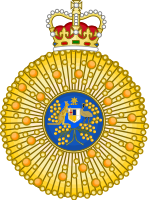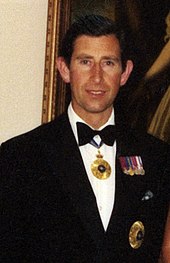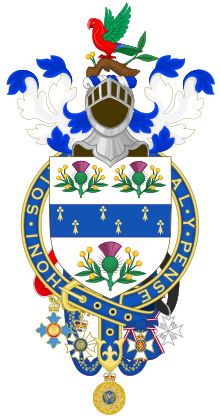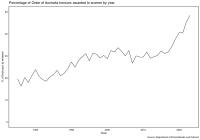The Order of Australia is an Australian honour that recognises Australian citizens and other persons for outstanding achievement and service.[1] It was established on 14 February 1975 by Elizabeth II, Queen of Australia, on the advice of then prime minister Gough Whitlam. Before the establishment of the order, Australians could receive British honours, which continued to be issued in parallel until 1992.
| Order of Australia | |
|---|---|
 Insignia of knights and dames of the Order of Australia | |
| Awarded by the Governor-General of Australia | |
| Type | National order |
| Eligibility | All living Australian citizens (non-citizens eligible for honorary awards) |
| Awarded for | Achievement and merit in service to Australia or humanity |
| Founder | Elizabeth II on the advice of Gough Whitlam |
| Sovereign Head | Charles III, King of Australia |
| Chancellor and Principal Companion | Samantha Mostyn, Governor-General |
| Grades |
|
| Former grades | Knight/Dame (AK/AD)[note 1] |
| Website | Official website and nomination portal |
| Statistics | |
| First induction | 14 April 1975 |
| Last induction | 2024 King's Birthday Honours |
| Total inductees | Total as of July 2024[update]
|
Ribbons: general division; military division | |
Appointments to the order are made by the governor-general, "with the approval of The Sovereign",[a] according to recommendations made by the Council for the Order of Australia.[3] Members of the government are not involved in the recommendation of appointments, other than for military and honorary awards.
The King of Australia is the sovereign head of the order,[1][4] and the governor-general is the principal companion and chancellor of the order. The governor-general's official secretary, Paul Singer (appointed August 2018), is secretary of the order.
Levels of membership
The order is divided into a general and a military division. The five levels of appointment to the order in descending order of seniority are:
- Knight and Dame of the Order of Australia (AK and AD – no longer awarded);[note 1][5][6][7]
- Companion of the Order of Australia (AC – quota of 35 per year);[7]
- Officer of the Order of Australia (AO – quota of 140 per year);[7]
- Member of the Order of Australia (AM – quota of 605 per year);[7][8]
- Medal of the Order of Australia (OAM – no quota).[note 2]
Honorary awards at all levels may be made to non-citizens. These awards are made additional to the quotas.
Insignia
The order's insignia was designed by Stuart Devlin.
The badge of the Order of Australia is a convex disc (gold for AKs, ADs and ACs, gilt for AOs, AMs and OAMs) representing a single flower of mimosa. At the centre is a ring, representing the sea, with the word Australia below two branches of mimosa. The whole disc is topped by the Crown of St Edward. The AC badge is decorated with citrines, blue enamelled ring, and enamelled crown. The AO badge is similar, without the citrines. For the AM badge, only the crown is enamelled, and the OAM badge is plain. The AK/AD badge is similar to that of the AC badge, but with the difference that it contains at the centre an enamelled disc bearing an image of the coat of arms of Australia.[note 1] The colours of royal blue and gold are taken from the livery colours of the Commonwealth Coat of Arms, the then national colours.
The star for knights and dames is a convex golden disc decorated with citrines, with a blue royally crowned inner disc bearing an image of the coat of arms of Australia.
The ribbon of the order is royal blue with a central stripe of mimosa blossoms. Awards in the military division are edged with 1.5 mm golden bands.[9] AKs, male ACs and AOs wear their badges on a necklet and male AMs and OAMs wear them on a ribbon on the left chest. Women usually wear their badges on a bow on the left shoulder, although they may wear the same insignia as males if so desired.
A gold lapel pin for daily wear is issued with each badge of the order at the time of investiture; AK/AD and AC lapel pins feature a citrine central jewel, AO and AM lapel pins have a blue enamelled centre and OAM lapel pins are plain.
Membership
The order currently consists of four levels (one discontinued) and the medal, in both general and military divisions. Since 2015, the knight/dame level has been discontinued on the advice of then prime minister Malcolm Turnbull. Awards of knight and dame of the order were made in the general division only.[note 3]
Award criteria in detail
The different levels of the order are awarded according to the recipients' levels of achievement:
| Award | Criteria (general division) | Criteria (military division) | Quota |
|---|---|---|---|
| Knight/Dame (AK/AD) (No longer awarded)[7] | "Extraordinary and pre-eminent achievement and merit of the highest degree in service to Australia or to humanity at large." | Not awarded |
|
| Companion (AC) | "Eminent achievement and merit of the highest degree in service to Australia or to humanity at large." | "Eminent service in duties of great responsibility." | |
| Officer (AO) | "Distinguished service of a high degree to Australia or to humanity at large." | "Distinguished service in responsible positions." | |
| Member (AM) | "Service in a particular locality or field of activity or to a particular group." | "Exceptional service or performance of duty." | |
| Medal (OAM) | "Service worthy of particular recognition." | "Meritorious service or performance of duty." | No quota |
Nomination and appointment

Since 1976 any Australian citizen may nominate any person for an Order of Australia award. People who are not Australian citizens may be awarded honorary membership of the order at all levels. Nomination forms are submitted to the Director, Honours Secretariat, a position within the Office of the Official Secretary to the Governor-General of Australia, at Government House, Canberra,[13][14] which are then forwarded to the Council for the Order of Australia.[7] The prime minister of the day appoints the Council chair and seven "community representatives", while each state and territory appoints its representative and there are other ex officio members. The Council chair as of January 2023 is Shelley Reys.[15]
The Council makes recommendations to the governor-general.[7] Awards are announced on Australia Day and on the King's Birthday public holiday in June, on the occasion of a special announcement by the governor-general (usually honorary awards), and on the appointment of a new governor-general. The governor-general presents the order's insignia to new appointees.[7]
Appointments to the order are not made posthumously; however, if a nominee dies after accepting an appointment but before the relevant announcement date, the appointment stands and it is announced as having effect from no later than the date of the nominee's death. Awardees may subsequently resign from the order, and the Council may advise the governor-general to remove an individual from the order, who may cancel an award.[note 4] [16][17]
Announcements of all awards, cancellations and resignations appear in the Commonwealth Gazette. Nomination forms are confidential and not covered by the Freedom of Information Act 1982 (Cth).[18] The reasoning behind a nomination being successful or unsuccessful—and even the attendees of the meetings where such nominations are discussed—remains confidential.[19]
History
Establishment

The Order of Australia was established on 14 February 1975 by letters patent of Queen Elizabeth II, acting as Queen of Australia, and countersigned by then prime minister, Gough Whitlam. The original order had three levels: Companion (AC), Officer (AO) and Member (AM) as well as two divisions: Civil Division and Military Division. At the time it was also announced that Australian prime ministers would no longer nominate persons for British Imperial honours, but this new practice did not extend to nominations by state premiers. According to the governor general's then-secretary Sir David Smith, Whitlam was furious when he first saw Devlin's design for the insignia of the order, due to the inclusion of a representation of the states (with whom Whitlam's government was constantly in dispute) through the state badges within the Commonwealth Coat of Arms.[20]
On 24 May 1976, the level of Knight (AK) and Dame (AD) and the Medal of the Order of Australia (OAM), were created by the Queen on the advice of Whitlam's successor, Malcolm Fraser, and the Civil Division was renamed the General Division. The level of Knight/Dame was awarded only in the General Division.
The original three-level structure of the Order of Australia was modelled closely upon the Order of Canada,[21][22] though the Order of Australia has been awarded rather more liberally, especially in regard to honorary awards to non-citizens. As of July 2024[update] only 30 non-Canadians have been appointed to the Order of Canada, while 537 non-Australians have been appointed to the Order of Australia, with 46 to the Companion level.
Yvonne Kenny AM represented the Order at the 2023 Coronation.[23]
Knights and dames


Following the 1983 federal election, Prime Minister Bob Hawke advised the abolition of the knight/dame level. On 3 March 1986, the Queen co-signed letters patent revoking the level, with existing knights and dames not being affected by the change. In the period 1976–1983, twelve knights and two dames were created.
On 19 March 2014, monarchist prime minister Tony Abbott advised the Queen to reinstate the level of knight/dame and the Queen co-signed letters patent to bring this into effect. The change was publicly announced on 25 March, and gazetted on 17 April 2014.[24] Up to four knights or dames could be appointed each year, by the Queen of Australia on the advice of the prime minister after consultation with the chairman of the Order of Australia Council.[5][25]
Five awards of knight and dame were then made, to the outgoing governor-general, Quentin Bryce; her successor, Peter Cosgrove; a recent chief of the Defence Force, Angus Houston; a recent governor of New South Wales, Marie Bashir; and Prince Philip. This last award was widely met with ridicule and dismay by many in the Australian media.[26][27] The award was also heavily criticised in the community, with 72% disapproving and 12% in favour in a ReachTEL poll.[28]
The Australian Labor Party continued to oppose knighthoods and damehoods. Leader of the opposition Bill Shorten stated in March 2014 that the party would again discontinue the level if it were to win the next Australian federal election.[29]
The knighthood decision was a significant factor that caused Liberal party members to question Abbott's leadership,[30][31] with Malcolm Turnbull succeeding in a challenge to take the prime ministership in September 2015. Two months after coming into office, the new republican prime minister announced that the Queen had approved his request to amend the Order's letters patent and cease awards at this level.[32][33] Existing titles would not be affected.[6] The move was attacked by monarchists[34] and praised by republicans.[35][36] The amendments to the constitution of the Order were gazetted on 22 December 2015.[37]
Current membership
Officials of the order
- Sovereign Head of the Order: King of Australia (Charles III)
- Chancellor and Principal Companion: Governor-General of Australia (Samantha Mostyn)
- Secretary: Official Secretary to the Governor-General of Australia (Paul Singer)
King Charles III, when he was Prince of Wales, was appointed a Knight of the Order of Australia (AK) on 14 March 1981. As he is not an Australian citizen, even though he was the heir to the Australian throne at the time, this would have required the award to be honorary. To overcome this issue, his appointment was created by an amendment to the constitution of the Order of Australia by special letters patent signed by the Queen, on the recommendation of Prime Minister Malcolm Fraser.[38]
In March 2014 the knight and dame levels, which had been abolished in 1986 by Prime Minister Bob Hawke, were reintroduced to the Order of Australia by Tony Abbott. At the same time, Abbott announced that future appointments at this level would be recommended by the prime minister alone, rather than by the Council of the Order of Australia, as is the case with all lower levels of the order. In accordance with the statutes of 2014, Prince Philip, Duke of Edinburgh, was created a Knight of the Order by letters patent signed by the Queen on 7 January 2015, on Abbott's advice.[39] Prince Philip's knighthood was announced as part of the Australia Day Honours on 26 January 2015 and his appointment attracted criticism of what Abbott described as his "captain's call". Abbott responded by announcing that future recommendations for appointments as Knights and Dames of the Order would be determined by the Council of the Order of Australia.[citation needed]
Honorary awards
Awards of the Order of Australia are sometimes made to people who are not citizens of Australia to honour extraordinary achievements. These achievements, or the people themselves, are not necessarily associated with Australia, although they often are. On 1 July 2024, the Australian Honours website listed appointments for 46 Honorary Companions, 118 Honorary Officers, 174 Honorary Members of the Order of Australia and the award of 199 Honorary Medals of the Order of Australia.[40] Notable honorary awards include:
- Honorary Companion
- All Honorary Companions of the Order of Australia are notable – see List of Honorary Companions of the Order of Australia
- Honorary Officer
- Ali Alatas, Mel Gibson, Maina Gielgud, Hiroyuki Iwaki, Clive Lloyd, Lord Morris of Manchester, U.S. General David Petraeus,[41][42] Admiral Harry Harris, Jerzy Toeplitz, Julius Tahija,[43] Edo de Waart, Malcolm Williamson, Googie Withers and James Wolfensohn
- Fred Hollows, then a New Zealand citizen, was offered an honorary Officership in 1985, but declined the award; he became an Australian citizen in 1989, and in 1991 was appointed a substantive Companion of the Order
- Romaldo Giurgola was appointed an honorary Officer in 1989; this became a substantive award in 2000 when he adopted Australian citizenship
- See also: Category:Honorary Officers of the Order of Australia
- Ali Alatas, Mel Gibson, Maina Gielgud, Hiroyuki Iwaki, Clive Lloyd, Lord Morris of Manchester, U.S. General David Petraeus,[41][42] Admiral Harry Harris, Jerzy Toeplitz, Julius Tahija,[43] Edo de Waart, Malcolm Williamson, Googie Withers and James Wolfensohn
- Honorary Member
- Harriet Mayor Fulbright, Lord Harewood, John Williams, Brian Lara, Sachin Tendulkar and Robyn Williams.
- Terri Irwin was appointed an Honorary Member in 2006; this became a substantive award when she became an Australian citizen in 2009
- See also Category:Honorary Members of the Order of Australia
- Harriet Mayor Fulbright, Lord Harewood, John Williams, Brian Lara, Sachin Tendulkar and Robyn Williams.
Gender breakdown

Since 1975, just over 30 per cent of recipients of an Order of Australia honour have been women.[44] The number of nominations and awards for women is trending up, with the 2023 Australia Day Honours resulting in the highest percentage of awards for women to date (47.1 per cent, 47.9 per cent in the general division).[45] Advocacy groups such as Honour a Woman and the Workplace Gender Equality Agency have called for greater effort to be made to reach equal representation of men and women in the order.[44][46]
Sociology of recipients of highest levels
In December 2010, The Age reported a study of the educational backgrounds of all people who had received Knight/Dame and Companion level awards at that time. It reported: "An analysis of the 435 people who have received the nation's top Order of Australia honours since they were first awarded in 1975, shows they disproportionately attended a handful of elite Victorian secondary schools. Scotch College alumni received the highest number of awards, with 19 former students receiving Australia's [then] highest honour".[47][note 5]
Lists of recipients in categories
Order of Australia Association
On 26 January 1980 the Order of Australia Association was created as an incorporated body that award recipients could become members. Its stated purpose is to support the "community and social activities" of members while also promoting and encouraging the nomination of other Australians to the Order.[48] The Order also runs a foundation that provides scholarships to tertiary students that show potential as future leaders and are involved in community activities.[49] Branches of the association are in all the states and territories of Australia as well as the UK and the USA.[50]
Total inductees
Total inductees as of July 2024[update].[51]
| All levels | Knight/Dame (AK/AD) | Companion (AC) | Officer (AO) | Member (AM) | Medal (OAM) | |
|---|---|---|---|---|---|---|
| Civil/General division | 15,360[b] | 19 | 577 | 3182 | 11,582 | |
| Military division | 1660[b] | Not awarded | 24 | 293 | 1343 | |
| Honorary general division | 311[b] | 0 | 45 | 95 | 171 | |
| Honorary military division | 27[b] | Not awarded | 1 | 23 | 3 | |
| Total honorary awards | 537 | 0 | 46 | 118 | 174 | 199 |
| Total substantive awards | 47,332 | 19 | 601 | 3475 | 12,925 | 30,312 |
| Total awards | 47,869 | 19 | 647 | 3593 | 13,099 | 30,511 |
Precedence
The order of wearing Australian and other approved honours is determined by the government.[52]
| Preceding | Level | Following |
|---|---|---|
| Member of the Order of Merit (OM) | Knight/Dame | Knight/Dame Grand Cross of the Order of St Michael and St George (GCMG) |
| Knight/Dame Grand Cross of the Order of the British Empire (GBE) | Companion | Companion of Honour (CH) |
| Knight Bachelor | Officer | Companion of the Order of the Bath (CB) |
| Distinguished Service Cross (DSC) | Member | Lieutenant of the Royal Victorian Order (LVO) |
| Australian Intelligence Medal (AIM) | Medal | Order of St John |
References in popular culture
The award is parodied in the play Amigos, where the central character is determined to be awarded the AC, and uses persuasion, bribery and blackmail in his (ultimately successful) attempts to get himself nominated for the award.[53]
During the 1996 season of the popular television programme Home and Away, the character Pippa Ross was awarded a Medal of the Order of Australia for her years of service as a foster carer.
See also
Notes
References
General references
- "Order of Australia Handbook" (PDF) (16th ed.). Government House, Canberra: Office of the Official Secretary to the Governor-General. August 2023.
- "Constitution of the Order of Australia". Federal Register of Legislation. Australian Government. 16 April 2018.
- "Australian honours system". Department of Prime Minister and Cabinet. Australian Government. Retrieved 25 June 2024.
Specific references
Further reading
- Fox, Karen (2022). Honouring a Nation: A History of Australia's Honours System. Canberra, ACT, Australia: Australian National University Press. ISBN 978-1-76046-500-1.
External links

- Australian Honours Search Facility
- Order of Australia Association - official website